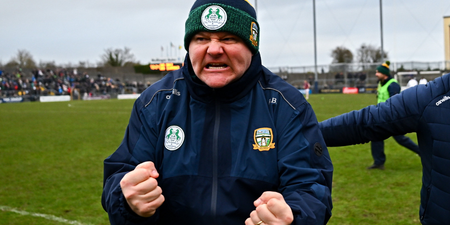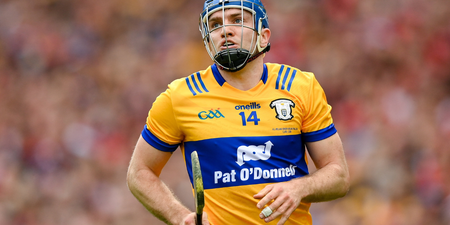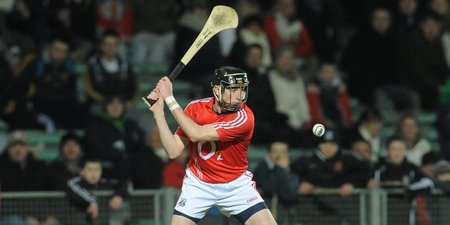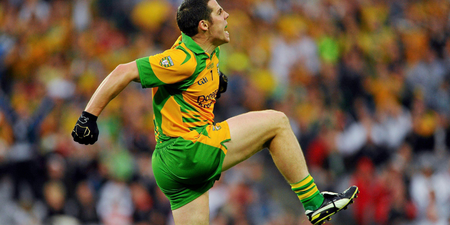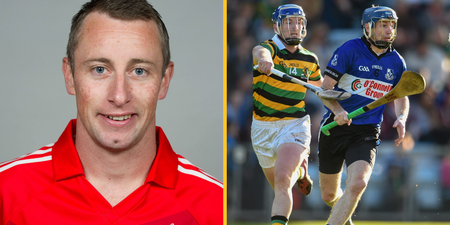With the draw set to keep just about everybody’s top four of Dublin, Kerry, Tyrone and Mayo on course for the semi-finals, Monaghan come to Croker on Saturday intent on upsetting the apple-cart. While the Dubs are overwhelming favourites, Monaghan may well be quietly confident.
TEXTBOOK TACTICS FOR CHALLENGING DUBLIN
Since Donegal’s 2014 slaying of Dublin, almost every side who’ve run Dublin close (or beaten them in the case of Kerry) have tried to follow suit of Donegal and choke off Dublin’s short kick-out, especially the quick, short kick-out.
They’ve understood the importance of not allowing Dublin to dictate the play, gain easy possession, play the game at a hundred miles an hour, and get a frightening ratio of scores off quick kick-outs.
What Kerry, Tyrone, Donegal, maybe Mayo, and probably Monaghan, have worked out is just how poor Dublin are on breaks off their own kick-outs if Stephen Cluxton is forced to send it long for a 50/50.
In six games against those five sides in the league this year, they won four and lost 19 breaks off their own long kick-outs. For all of Jim Gavin’s meticulous planning, this one element appears to have eluded him. Efficient oppositions typically queue up under the breaks off these Dublin kick-outs.
Cluxton has to go long
Per usual, Dublin’s opponents occupy the likely break winning area
Strangely, Monaghan are the only side in this group who haven’t made a massive effort/successful attempt forcing Dublin long like this. Monaghan simply haven’t committed the amounts of players to the counter-attack to date to be in position to consistently go man-on-man on Dublin’s kick-out like Kerry, Tyrone and Mayo do. Only two of Cluxton’s long kick-outs in the league against Monaghan forced a break. Monaghan won both.
In that game, Dublin got off 14 quick kick-outs to free players in the full back line, half back line or midfield. From these 14 attacks, they scored 1-8, and conceded just two points upon the initial turnover. That’s a massive 0.64 points per quick kick-out. Better handling and shooting and it could have been 3-8.
Cluxton gets the ball ASAP
And has it kicked in five seconds
And the line is broken
One pass takes out the Monaghan middle third
And Dublin are one-on-one 24 seconds later
What appears bizarre on the surface is that with such figures, Monaghan kept the game to level scores until the final minute.
MONAGHAN’S DEFENCE AND COUNTER-ATTACK
On a one-dimensional level, you might think that you should expect Monaghan to turn Dublin over if they managed to go man-on-man on more Dublin kick-outs. Of course, it’s not so simple.
The key to Monaghan’s efficiency is that they typically don’t risk being caught out at the back by committing too many men forward, even when they counter-attack. The sweeper appears sacrosanct.
In a tactical assault by Malachy O’Rourke, that deserves huge credit, they kept Dublin to just three man-on-man attacks in that league game, while creating seven. They scored 1-5 from these seven attacks, a 1.14 point per attack ratio.
They counter-attack at pace when they can, but they always leave numbers at the back.
Albeit, running against the grain of what all other contenders are doing, it appears to be work. Let’s face it – man-on-man Dublin are far superior. Quick kick-outs taken out of the equation, Dublin scored just 1-6 in that league game.
MONAGHAN’S KICK-OUTS
A key piece of statistical analysis is that from 14 Monaghan kick-outs to the defence in the league encounter, they managed five points and only conceded two on the first turnover. It’s a significant figure, coming in at 21 percent kick-out to score ratio.
On the day, in the league, they drew two points apiece with Dublin on their long kick-outs, but typically, Dublin have ravaged oppositions in this regard. The long kick-out a risky road to go down against the Dubs. Also, they conceded three points from four long kick-outs to midfield against Down in Croke Park.
Just as earning short possession on the kick-out was the cornerstone of Roscommon’s assault on Mayo last week, it could potentially be equally so for Monaghan.
Of course, there’s the possibility that they’ll try to expose Dublin using a tactic which has been significant in both Armagh’s and Carlow’s respective runs this year, which Colm Parkinson pointed out on the GAA hour on Monday.
As Dublin push up man-on-man on the kick-out, they can go over the top. Win it long and they’ll attack three-on-three or two-on-two, ala Donegal in 2014. Lose it and they’re set up with 12 behind the ball.
Saying that Carlow clearly applied this tactic in the Leinster opener and it could have worked had they actually won a kick-out over the top. Saying that Jonny Cooper and others did flitter between going man-on-man and dropping into space. If it becomes an issue for Dublin, I suspect they’ll change tack pretty quickly. They surely haven’t completely forgotten the Donegal affair in 2014.
Over 70 minutes I suspect there’ll be more value in the short kick-out.
Carlow went over the top of seven at the back
And four more, but James McCarthy held the space on this occasion
MONAGHAN’S CONCERN
Despite such positive statistical readings on so many levels against Dublin in the league, there are overlapping patterns from the respective sides’ previous games in Croke Park which suggest that we may not expect Monaghan to be so effective at the back this time around.
After the Leinster final, we looked at how efficient Dublin were when they attacked by taking the ball at 45 degree angles against Kildare. From 22 such attacks, they scored a massive 2-14, a 91 percent points per attack ratio, while only failing to get off a shot once.
In the first half of Monaghan’s clash with a Down side, grossly inferior to Dublin in raw ability, Down tore Monaghan’s defence apart with ease, scoring 1-9. The once they attacked using the 45 degree run they scored all too easily.
Down attack at an angle
Drawing two, not one, defender to the ball
Before three converge on the same space
But the ball is shifted back again
To easily leave the shooter in acres of space despite the blanket defence
To be fair to Monaghan, they tightened up significantly in the second, again, illustrating their potential capacity to defend efficiently. The first half did, however, illustrated huge potential defensive frailties which Dublin could ferociously expose.
Will Monaghan have the legs?
The advantage of Monaghan not systematically trying to go man-on-man against Dublin on the kick-outs is that they’re not easily exposed man-on-man at the back. The flip-side, which accounted for their annihilation in 2014, is that it forces half forwards and midfielders to spend the entire game traipsing from one end to the other all day. It’s effective but very difficult to maintain this all day.
Monaghan have eight defenders in proximity to the ball
On one hand, you could argue that they did it this way in the league and were level in the 69th minute against a Dublin side with only two strangers to championship football. On the other hand, you could point out that they had conceded a point on average every 5.5 minutes up to the 48th minute and conceded a point every 2.3 minutes in the final 26 minutes of play (calculating goals and points).
A look at their defensive unit suggests that their efficiency diminished hugely in the final quarter.
Monaghan are well set up defensively late on
Before Lowndes makes the 45 degree run
And Rock brings it back
To McMahon who comes at 45 degrees
And gets a shot off all too easily
Though not hugely significant it’s not completely insignificant that these players in the middle third will have an extra three metres to traipse back in Croke Park compared to Clones, and the same to get forward again.
CONCLUSION
Monaghan ran, a not far off full strength, Dublin so close in the league that 9/1 odds on a Monaghan win seem very generous. There are patterns which suggest that it’s not beyond reason that they could pull it off.
Get their kicks off to the full back line and there’s evidence they could successfully “pick and poke” their way forward for scores. Force Dublin long for 50/50 kick-outs a few times more and you could expect them to save a point per two kicks. Get men behind the ball and there’s evidence that they can keep Dublin at bay.
Of course, by reducing the amount of quick, short Dublin kick-outs, they compromise their defensive structure, the proverbial “robbing of Peter to play Paul”.
If they could consistently and meticulously manage two out of these three, if everything McCarron and McManus touch turn to gold, and every little thing would go their way, it’s not beyond reason that they could lead narrowly on the 60-minute mark.
Even then, though, all evidence points to a potential late Dublin onslaught. And as 12 man defences have become the norm, Dublin’s capacity to “pick and poke” their way through them is unrecognizably efficient compared to 2014. Late in the game at least, Monaghan have shown some frailties in this regard.
It’s not beyond reason, but the slightest chink in Monaghan’s armour and you have to fancy Dublin to keep them at arm’s length. Even with everything tiny detail going right, it’s 50/50 at best. It’ seems fairly unlikely.
Stephen O’Meara is creator and founder of www.gaaprostats.com, statistical and video analysis software created specifically for Gaelic football and hurling.
































